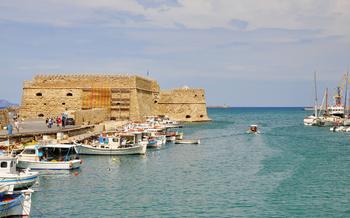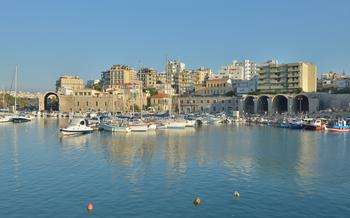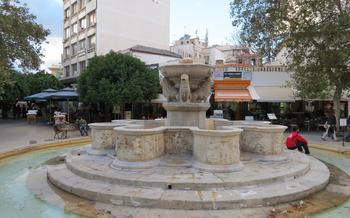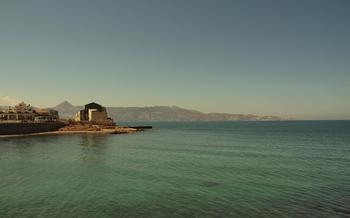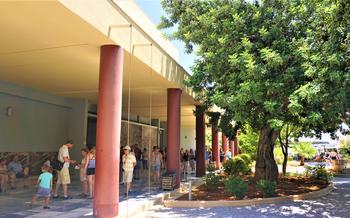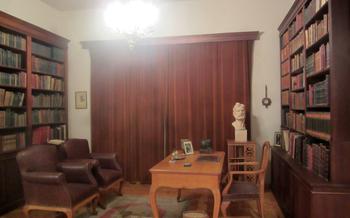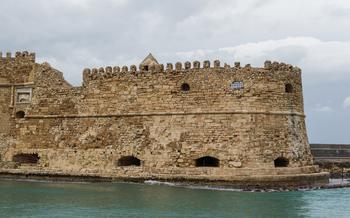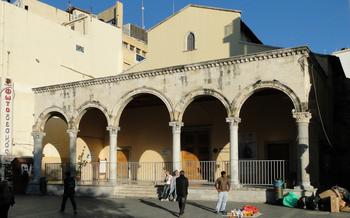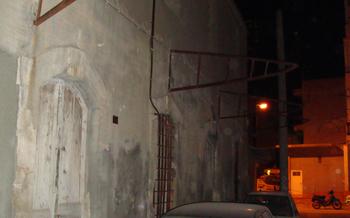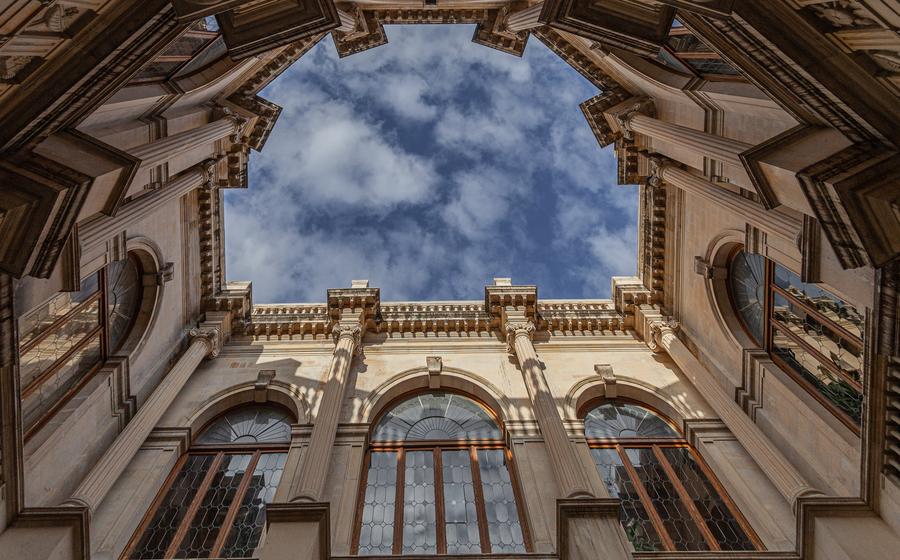
Venetian Loggia
- Venetian Loggia: A Historical Gem in Heraklion's Heart
- Exploring the Loggia's Unique Architecture
- A Walk Through Time: The Loggia's Historical Context
- Unveiling the Loggia's Cultural Legacy
- Tips for Visiting the Venetian Loggia
- The Loggia as a Symbol of Venetian Power
- The Loggia's Contribution to Venetian Administration
- Venetian Architectural Legacy in Heraklion
- The Loggia's Enduring Legacy
- The Loggia's Role in Modern Heraklion
- Exploring the Loggia's Surroundings
- The Loggia's Transformation Over Time
- Insider Tip: Capturing the Loggia's Charm
Venetian Loggia: A Historical Gem in Heraklion's Heart
In the vibrant city of Heraklion, nestled within the heart of Crete, stands a testament to the city's rich history and Venetian heritage: the Venetian Loggia. This architectural masterpiece, dating back to the 16th century, is a symbol of Venetian power and influence during their reign over Crete. Today, the Loggia serves as a cultural venue and exhibition space, inviting visitors to delve into the depths of Heraklion's past while appreciating its enduring beauty.
The Venetian Loggia stands as a reminder of Crete's diverse cultural tapestry, blending Venetian Gothic and Renaissance architectural elements to create a unique and captivating structure. Its intricate carvings, decorative motifs, and central courtyard with arcades and columns showcase the exceptional craftsmanship and artistry of the Venetian era. As visitors stroll through the Loggia's grand halls, they are transported back in time, experiencing the grandeur and opulence that once defined Venetian rule in Crete.
Exploring the Loggia's Unique Architecture
The Venetian Loggia in Heraklion is an architectural masterpiece that showcases intricate carvings, decorative motifs, and a harmonious blend of Venetian Gothic and Renaissance styles. The facade is adorned with exquisite sculptures, depicting mythical creatures, biblical scenes, and historical events. The central courtyard, a hallmark of Venetian architecture, features elegant arches supported by slender columns, creating a serene and inviting space.
The Loggia's design reflects the Venetian Republic's artistic prowess and attention to detail. The combination of Gothic and Renaissance elements, evident in the pointed arches and decorative motifs, creates a visually captivating structure. The intricate carvings on the capitals of the columns, depicting human figures, animals, and foliage, showcase the skill and craftsmanship of Venetian artisans.
The Loggia's imposing presence in Heraklion's cityscape is undeniable. Its height and grandeur make it a focal point, drawing the attention of visitors and locals alike. The Loggia stands as a testament to the enduring legacy of Venetian rule in Crete, a symbol of the Republic's power and influence.
A Walk Through Time: The Loggia's Historical Context
Heraklion, the capital of Crete, fell under Venetian rule in 1204, marking a significant chapter in its history that lasted until 166During this period, the city flourished as a major trading hub and administrative center, leaving behind a rich legacy of Venetian architecture and culture. The Venetian Loggia, standing proudly in the heart of Heraklion, played a central role in this vibrant era.
Originally constructed in the 14th century, the Loggia served as a meeting place for Venetian officials, merchants, and dignitaries. Here, they discussed matters of governance, trade, and diplomacy, shaping the course of Heraklion's development. The Loggia witnessed countless historical events and decisions that left an indelible mark on the city's identity.
One of the most notable events associated with the Loggia is the famous "Cretan War" of 1645-1669, during which the Venetian Republic fought valiantly against the Ottoman Empire to retain control of Crete. The Loggia served as a command center for Venetian forces, and its walls echoed with the strategies and decisions that would determine the fate of the island. Despite their valiant efforts, the Venetians ultimately lost the war, and Crete came under Ottoman rule.
Unveiling the Loggia's Cultural Legacy
The Venetian Loggia, a stunning architectural masterpiece in the heart of Heraklion, is not just a historical monument but also a thriving cultural hub. Throughout the year, the Loggia hosts a diverse range of exhibitions and cultural events, showcasing the vibrant artistic scene of Crete.
From contemporary art exhibitions featuring local and international artists to historical displays highlighting the rich heritage of the island, the Loggia offers a platform for cultural expression and dialogue. Collaborations with museums and galleries bring unique collections and artifacts to life, providing visitors with a deeper understanding of Crete's fascinating past.
The Loggia also serves as a venue for concerts, performances, and workshops, fostering a sense of community and celebrating the diverse talents of the region. Through these events, the Loggia becomes a melting pot of cultures, where visitors can immerse themselves in the creativity and passion of the local artistic community.
The Loggia's role in promoting local art and culture extends beyond its own walls. It actively collaborates with educational institutions, offering guided tours and workshops for students, fostering appreciation for the city's heritage and inspiring future generations of artists and cultural enthusiasts.
By embracing its cultural legacy, the Venetian Loggia has transformed into a vibrant center for contemporary artistic expression, contributing to the cultural richness and dynamism of Heraklion.
Tips for Visiting the Venetian Loggia
Essential Information
Visiting the Venetian Loggia is a must-do for anyone interested in exploring Heraklion's rich history and culture. The Loggia is open to the public from 8 am to 8 pm daily, with an admission fee of 2 euros. Guided tours are available upon request, providing visitors with a deeper insight into the Loggia's history and significance. Additionally, audio guides in various languages are available for rent, offering a self-guided tour experience.
Accessibility and Convenience
The Venetian Loggia is conveniently located in the heart of Heraklion's Old Town, making it easily accessible on foot or by public transportation. The Loggia is wheelchair accessible, ensuring that all visitors can enjoy exploring this historical gem.
Combining Attractions
Make the most of your visit to Heraklion by combining a trip to the Venetian Loggia with other nearby attractions. The Loggia is situated just steps away from the Historical Museum of Crete, the Archaeological Museum of Heraklion, and the Venetian Walls. This proximity allows you to create a comprehensive itinerary exploring Heraklion's rich past and diverse cultural offerings.
The Loggia as a Symbol of Venetian Power
The Venetian Loggia stands proudly in Heraklion's main square, a testament to the city's rich history and the enduring legacy of Venetian rule. Its strategic location, imposing architecture, and symbolic significance all contribute to its status as a symbol of Venetian power and authority.
The Loggia's position in the heart of Heraklion, overlooking the bustling square, was carefully chosen to assert Venetian dominance over the city. Its imposing size and elaborate design further emphasized this power, projecting an image of strength and grandeur. The Loggia's architectural features, such as the intricate carvings, decorative motifs, and the central courtyard with its arcades and columns, showcased the artistry and skill of Venetian craftsmen.
As the seat of Venetian governance in Heraklion, the Loggia served as a physical representation of Venetian authority. Venetian officials conducted business, administered justice, and maintained order and stability within its walls. The Loggia's presence in the heart of the city was a constant reminder of Venetian power and influence, shaping Heraklion's urban landscape and serving as a symbol of Venetian Crete's grandeur.
The Loggia's Contribution to Venetian Administration
The Venetian Loggia in Heraklion served as the administrative center of Venetian rule in the city. Venetian officials, known as rectors, conducted business and administered justice within the Loggia's walls. These officials were responsible for maintaining order and stability in the city, ensuring that Venetian laws and regulations were upheld. The Loggia's strategic location in the heart of Heraklion's main square symbolized Venetian authority and power. It was here that important decisions were made, policies were implemented, and justice was dispensed. The Loggia's enduring presence as a symbol of Venetian governance stands as a testament to the efficiency and organization of the Venetian administration in Crete.
Venetian Architectural Legacy in Heraklion
The Venetian Loggia stands as a testament to the enduring legacy of Venetian architecture in Heraklion. This architectural style, characterized by its intricate carvings, pointed arches, and decorative motifs, is a prominent feature of many buildings in the city. The Loggia's ornate facade, with its Venetian Gothic design and Renaissance influences, is a prime example of this architectural style.
Other notable Venetian buildings in Heraklion include the Venetian Arsenal, a former shipyard and naval base, and the Venetian Walls, which once encircled the city and protected it from invaders. These structures, along with the Loggia, contribute to Heraklion's unique architectural identity, blending Venetian influences with local traditions.
The Venetian architectural legacy in Heraklion is not limited to individual buildings. The city's urban layout, with its narrow streets, piazzas, and arcades, also reflects Venetian influence. The Loggia, situated in the heart of Heraklion's Old Town, is a testament to the Venetian vision for the city, creating a harmonious blend of architectural styles and urban planning.
The Loggia's Enduring Legacy
The Venetian Loggia, a testament to Heraklion's enduring spirit, has stood tall through centuries of historical change. Despite the passage of time and the rise and fall of empires, the Loggia has retained its significance as a cultural landmark. Its adaptability to various uses and purposes has ensured its continued relevance in modern Heraklion. Today, the Loggia serves as a cultural venue, hosting exhibitions, performances, and events. It remains a source of pride for Heraklion's residents and a symbol of the city's rich and storied past. The Loggia's endurance is a reminder of Heraklion's resilience and its ability to embrace change while preserving its cultural heritage.
The Loggia's Role in Modern Heraklion
The Venetian Loggia stands as a testament to Heraklion's rich history and cultural heritage, drawing visitors from around the world. Its enduring charm and historical significance have made it a popular tourist attraction, contributing to Heraklion's thriving cultural tourism industry. The Loggia serves as a symbol of the city's resilience, having survived centuries of historical change and adaptation. For the residents of Heraklion, the Loggia is a source of pride, representing the city's deep-rooted connection to its Venetian past. The Loggia's enduring legacy ensures its continued relevance in contemporary Heraklion, attracting visitors and locals alike who seek to explore the city's rich history and cultural tapestry.
Exploring the Loggia's Surroundings
The Venetian Loggia occupies a prime location in the heart of Heraklion, surrounded by a wealth of historical and cultural attractions. A short stroll from the Loggia, visitors will find themselves immersed in the vibrant atmosphere of Heraklion's Old Town, with its narrow cobbled streets, charming shops, and traditional tavernas.
Within easy reach of the Loggia are several notable museums, including the Heraklion Archaeological Museum, home to the renowned Minoan artifacts from the Palace of Knossos. The Historical Museum of Crete offers a comprehensive overview of the island's rich history, while the Natural History Museum provides insights into Crete's diverse flora and fauna.
For those interested in exploring Heraklion's religious heritage, the imposing Cathedral of Saint Minas, with its impressive Byzantine architecture, is just a few steps away from the Loggia. Other nearby churches, such as the Church of Saint Titus and the Church of Our Lady of the Hundred Gates, offer a glimpse into the city's diverse religious traditions.
Archaeology enthusiasts will appreciate the proximity of the Venetian Walls, which once encircled the city, and the Koules Fortress, a majestic sea fortress built by the Venetians to protect Heraklion's harbor. These historical landmarks stand as testaments to Heraklion's rich past and offer visitors an opportunity to delve deeper into the city's captivating history.
Whether you're interested in history, culture, architecture, or simply soaking up the vibrant atmosphere of a Mediterranean city, the Venetian Loggia serves as an ideal starting point for exploring all that Heraklion has to offer.
The Loggia's Transformation Over Time
The Venetian Loggia has undergone various changes and transformations throughout its existence. Initially constructed as a symbol of Venetian power and authority, the Loggia's structure and appearance have evolved over the centuries. The original Gothic-style building underwent modifications during the Renaissance period, resulting in a blend of architectural styles. The Loggia's central courtyard was enclosed in the 19th century, creating additional space for exhibitions and events.
In the 20th century, the Loggia underwent extensive restoration and conservation efforts to preserve its historical significance. These efforts included repairing structural damage, restoring decorative elements, and cleaning the building's exterior. As a result of these efforts, the Venetian Loggia has regained its former glory and continues to stand as a testament to Heraklion's rich past.
Despite its changes over time, the Loggia's essence and purpose have remained consistent. It continues to serve as a cultural venue, hosting exhibitions, concerts, and other events that showcase the city's vibrant artistic and cultural scene. The Venetian Loggia remains a beloved landmark for both locals and visitors, symbolizing Heraklion's resilience and its enduring connection to its Venetian heritage.
Insider Tip: Capturing the Loggia's Charm
To truly capture the essence of the Venetian Loggia, plan your visit during the golden hours of sunrise or sunset. The warm hues of the morning or evening light cast a magical glow on the Loggia's facade, creating a picturesque backdrop for your photographs. Experiment with different angles to showcase the Loggia's architectural details and its harmonious blend with the surrounding cityscape. Don't miss the opportunity to capture the Loggia's reflection in the nearby Morosini Fountain, adding a touch of serenity and elegance to your shots. For the best results, use a tripod to ensure sharp images and consider bringing a wide-angle lens to capture the Loggia's grandeur in its entirety. Remember, the Venetian Loggia is a treasure trove of photographic opportunities, so don't hesitate to experiment and unleash your creativity.
